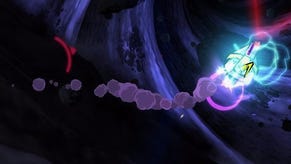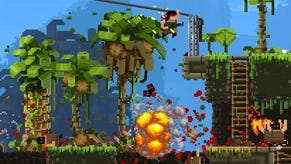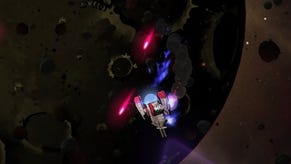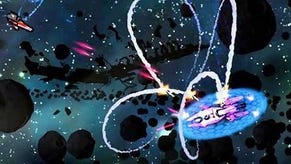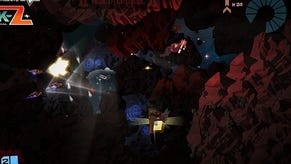Galak-Z preview: The PS4's secret weapon?
"Those are the bad guys: go shoot 'em all."
You don't slice through space in Galak-Z: The Dimensional. You tumble. It's a controlled kind of madness, really: a precision burst of the thrusters carrying you forward before you then pivot - facing up, down, backwards - to bestow showers of sparking laser fire on whatever most needs to be blown to pieces.
Homing missiles send clutches of fizzing contrails spiralling out behind them. Anime meteors explode in fat bursts of gas and debris. The shimmering interior walls of a hollow moon glow purple, then deep organic green and then warm, bubbling orange. For an instant, the carnage veers close to a pool of lava that sizzles beneath you, and in front of you, and even curves high over your head, too. Meanwhile, enemy fighters swarm and multiply in the shadows, ghosting outwards in daisy chains and scattering to dodge or to flank. Then you tumble away again, into the next dust cloud, onto the next battleground. It's amazing what you can get done in five seconds.
Jake Kazdal makes games that get right inside a genre, and then expand that genre's boundaries in unexpected ways. Skulls of the Shogun offered tactical battling that was as sharply honed as the glinting blade of its hero's katana, but it sped things up too, introducing players to a turn-based game that moved at the pace of an arcade classic. With Galak-Z, it's arcade classics themselves that get a reinvention. Kazdal's new space shooter has been created to evoke the kind of coin-op thrills he experienced playing at the greasy cabinets in his dad's pizza parlour when he was a kid, but he also wants to work on a larger scale. Asteroids and Centipede both get a name-checking - but so do Fallout 3, Rogue Legacy, Metroid, and GTA. Space-based dog-fighting in a procedural, flattened-out cosmos. Is this the first open-universe game?
It certainly felt like that during the brief glimpse we all got of Galak-Z during Sony's E3 press conference. Forget pricing and DRM strategies: for me, it's the indies that have really made the PlayStation 4 exciting. In amongst the assault rifles and the racing lines, the smaller teams had a great opportunity to surprise everyone this June. They did, too, unleashing colour, character, and genuine vibrancy. Unleashing space-based dog-fighting in a procedural, flattened-out cosmos.
It's not hard to see why Sony was so eager to get Galak-Z on stage. "I've always wanted to do this game," says Kazdal, when we chat over Skype. (The designer's chosen to use the oft-neglected Skype video option, too, so behind him I can see his team - now eight strong, apparently - working at clusters of computers in their art- and robot-strewn office.) "I hate to admit this but I'm not much of a 3D action gamer. There's too much ambiguity. There's too much unclarity: you're judging distances, fighting the camera, and you're never able to achieve that one-to-one connection. When I grew up and I was at the pizza parlour, I was playing all those hardcore arcade classic action games, I wanted to revisit those games today. Literally.Super tight, perfect controls, minimal input, one-to-one. I miss that twitch gaming."
Nostalgia's not the only component, however. "At the same time, I love first-person shooters," Kazdal continues. "I love Halo, Far Cry 3. The stuff you can do with that these days: artificial intelligence, encounters that are different every time you go in, hiding behind things, flanking, setting up a little plan - that seemed to be something that would work with arcade dog-fighting. I wanted to tie it all together: a classic arcade game with the best of modern tech, which means the best of modern physics, a new look which isn't just the race for realism. Who cares about realism? I wanted to do something super stylised that stuck out, and which people knew was a new game because they hadn't seen anything like it before."
If the game design was largely built on Western foundations, for the visuals - and the context - Kazdal once again looked to Japan. "Growing up, huge inspirations for me were watching Robotech, Macross, Starship Yamato. I remember waking up at six in the morning just to watch Star Blazers when I was a kid. That whole world of the cheesy costumes and the cheesy bad guys, the cheesy dialogue? I just want to do more of that. More of that kind of campy fun: a good old-fashioned adventure as you fight the bad dudes. No moral ambiguity. No, f*** that, man: those are the bad guys, go shoot 'em all. Straight-up old school good times."
A year into development, Galak-Z's story stuff is about to come online. What's already in place, though, is the control scheme - and it's not quite the control scheme you might be expecting. "It's such an organic input," Kazdal says, fingers twitching over an invisible pad as he talks. "When people saw it at E3, almost everyone assumed it was a twin-stick shooter, and it's not. It's more like Asteroids but with way more control. In Asteroids you had a thrust. Here you've got a thrust, a boost, you've got a backwards thrust and you can also do a side-strafe. And you can jump out of the plane for a moment and roll over enemies, missiles, in-coming fire. You've got those thrusters to learn, but it really clicks with the Halo-level AI. People are on patrol and you're flying backwards and forwards, jumping over volleys of lasers. Tight."
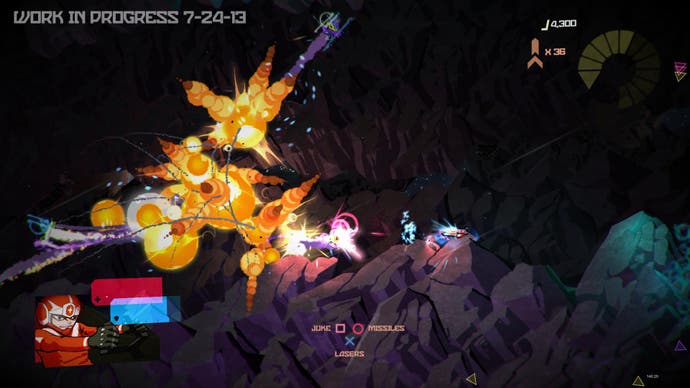
The arcade and anime credentials are well established, in other words. Now things start to get delightfully weird. "So much of the gameplay was inspired by my love of Grand Theft Auto," Kazdal muses.
Wait. Your love of what?
"I think GTA 3 is one of the greatest games of all time. Just the scramble of getting into trouble and all of a sudden there are one too many guys to handle so you're running, smashing into stuff. You understand the physics of the world, so you're very quickly able to have a plan, see the plan go to s***, freak out, and then figure something new out right there and then. It's the simple one-to-one relationship with the game that allows you to create these seat-of-your-pants moments. That simple panic, that sense of being good enough to be able to continue to exist gives me a real high, and I've put a lot of that in Galak-Z."
Is this where the game's more open-world structure comes from? "Yeah, kinda," says Kazdal, who's already lining up his next reference. "I actually really loved Halo: ODST. There would be these scripted missions where you went forward in a hallway and fought a bunch of guys. But there'd also be these roving bands of enemies and you'd just sneak around, too. You had these overarching goals - I need to go that way, to get to that spot - but there were patrols, and you could backtrack if you needed to get away. That ties into the GTA vibe: this huge space where you're running around trying to lose guys and do whatever it takes to find your own way in - stealthy or guns blazing.
"And remember we're dealing with space." Kazdal leans back in his chair and spreads his fingers wide. "You want it to be this big, infinite-feeling thing and there's no need to corral people in. So what Galak-Z does is it combines both thought processes. We have these dedicated missions which are in huge dungeon-like caves, and they're a bit more Super Metroid-y - another huge inspiration - as you explore, find cool new stuff. Outside of that, we have huge procedurally-generated swathes of space with asteroid fields, space pirates, and wrecks of old ships. You've got missions and things you can do that are finite, or you can just junk all that for a few hours and head off and stuff comes to you. There are imperials looking for you, there are space pirates, a faction of classic space bugs, and these guys don't necessarily get along with each other. You might come across this organic chaos where people are already fighting. You can even choose whether to engage or not in some cases."
It all comes down to what Kazdal refers to as "that live feeling" - live as in, "this report is coming to you live..." "It's about going east today, and just seeing what you might find," he enthuses. "It's Red Dead Redemption and Fallout 3, too: that modern awesomeness is something I just wanted to bring into the template of this classic shooter. Fallout 3, Red Dead, GTA: everytime you go to those places they're new. We want that, where there's always something new to do, always some new cool stuff to find. I like the idea of bringing in that roguelike stuff, too: regular checkpoints in the mission, but if you want to strike out, the further you get, the cooler the stuff you find but the harder the enemies are too - and you've got to come back to save your game. It's about balancing the hunt with the mission stuff. And the loot. Think Super Metroid. More missiles, stuff like that. And more incremental things: this gun is two percent better, or now I can shoot ice rockets or fire rockets, now I've found a blueprint for this super-cool cannon."
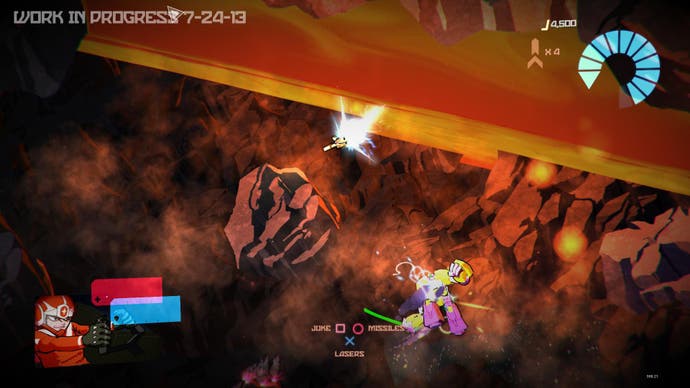
For all Kazdal's references, for all his name-checking and his forensic citing of specific influences, as I watch a video of him playing an early build for me while we chat over the top of the action, it strikes me that Galak-Z doesn't really feel like anything else. Warm synth gathers momentum as Kazdal vacuums in pick-ups, blasts space debris back and forth and unearths nests of aliens. Their ships judder towards him, thrumming and twitching like electric lawnmowers, while their teenage pilots babble threats over the comms. Using those thrusters just so Kazdal can dance between laser fire - tumbling and spinning, but still in control of it all, able to adjust pitch and balance with precision.
The enemies, meanwhile, are worryingly happy to break from their Galaxian patterns and think for themselves. There are no health bars to clutter the view, but you can get a sense of how much damage Kazdal's inflicting by the sparks and lightning their hulls give off as they start to malfunction.
The swarmers swarm and the baiters bait, to steal a phrase, and sometimes Kazdal has to duck into a hollow asteroid looking for a breather. Only, once he's in there, he discovers a giant flying mech, or a gaggle of sleek shark-like craft whose shields cast blue arcs around their pointed snouts. When cornered, he can juke out of the screen, or he can use the environment, strafing lava pools to send little lumps of molten death out into the playing field.
Even from this distance I can see it's all about that thrust - a system that requires mastery and an understanding of the physics of the world that just wouldn't be required in a twin-stick. The older Asteroids approach actually requires more thought here, more dexterity, just as reducing the dog-fighting to a fixed plane allows players to better focus on crucial elements like positioning and trajectories, rather than on flinging a 3D camera about as they scan the heavens for the single dot that's shooting at them from somewhere.
"I hate to ooze about how awesome this game is, but I just really love it," grins Kazdal. "It's one of those games that puts me in the zone. When you get good at it, stuff's coming at you like crazy, but you're just in this zen state. You get in that weird trance where you're thinking three turns ahead and predicting what's going to happen with real accuracy. If you're going to spend all your time making just one game - which means spending all your time playing just one game - you'd better make it rad."
He laughs once more and we continue to take it all in. The pollen drifting from a cosmic dandelion, the squeal of space jockeys panicking in the deep, the play of lights as the universe erupts.



